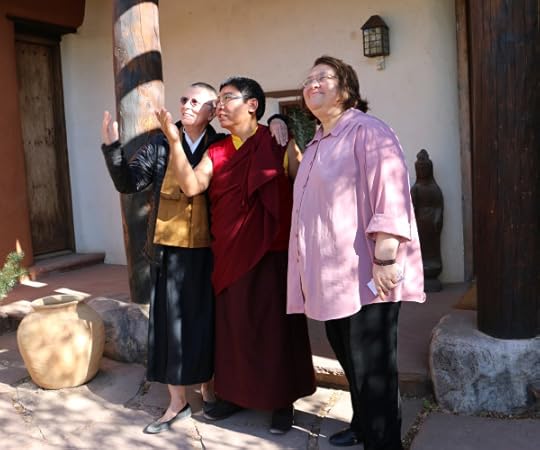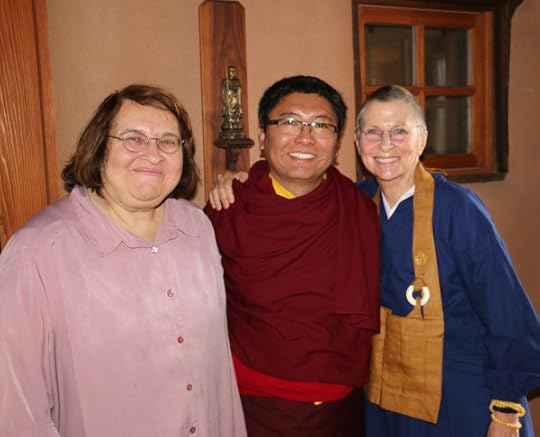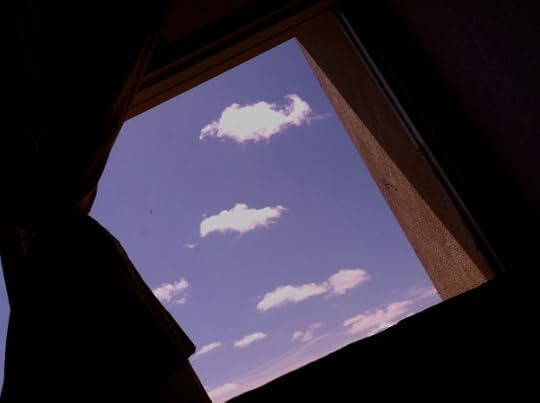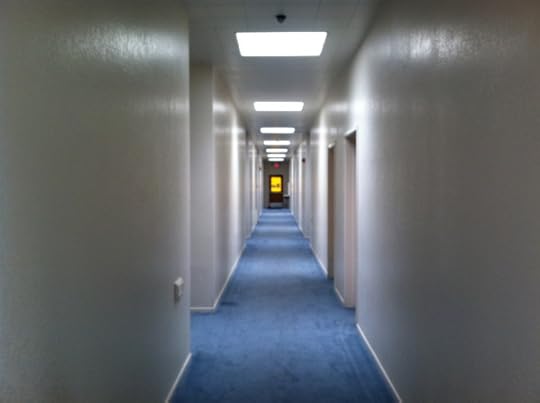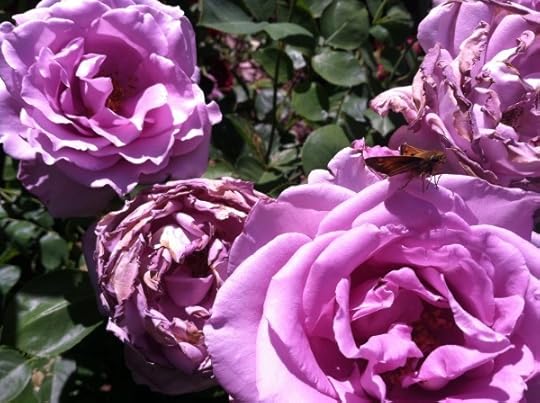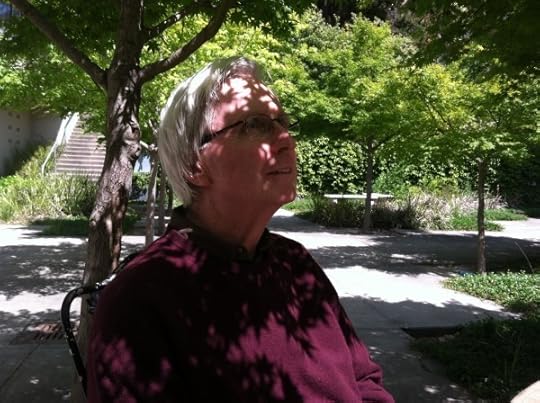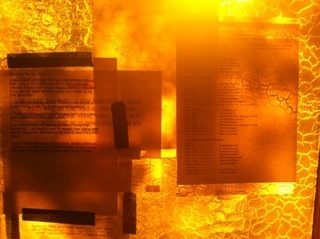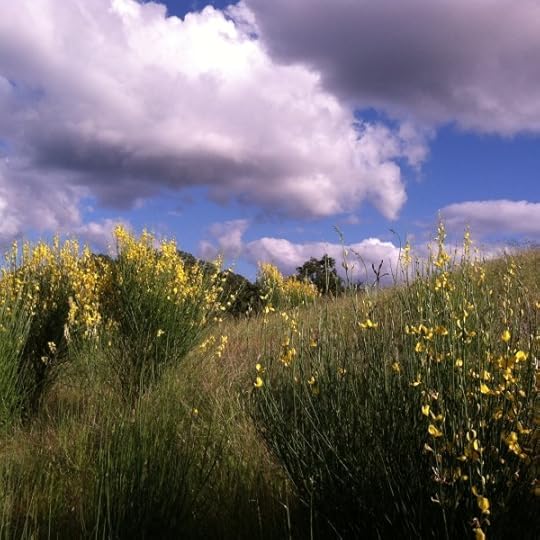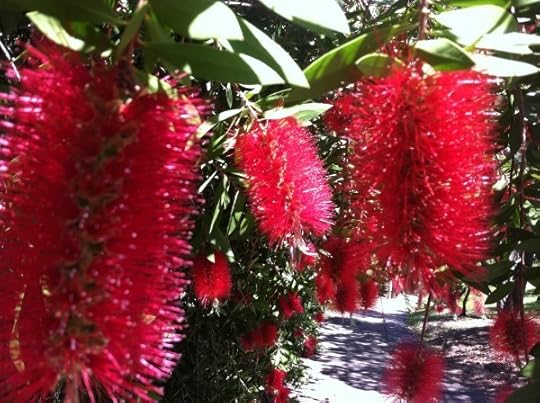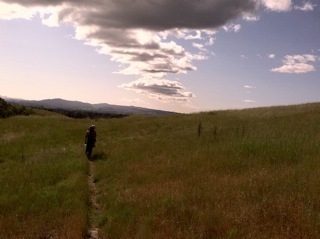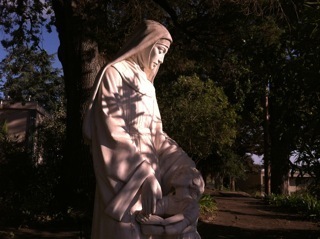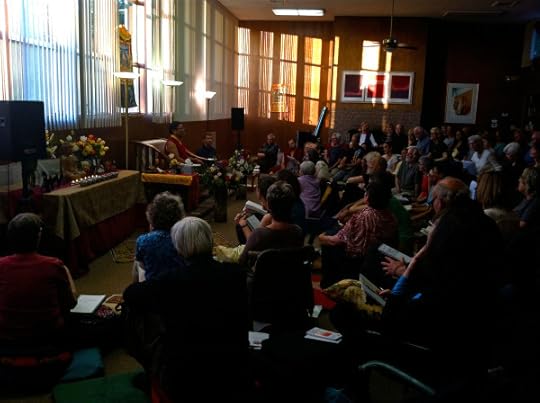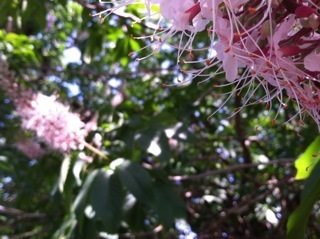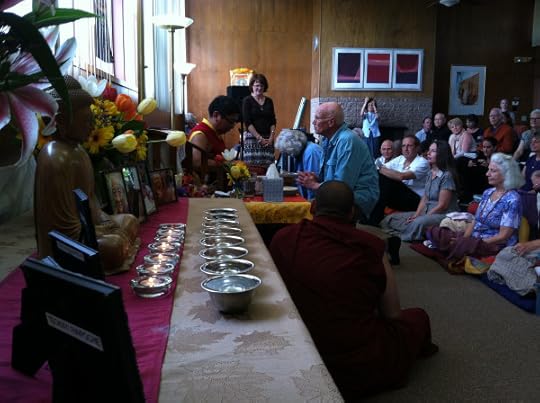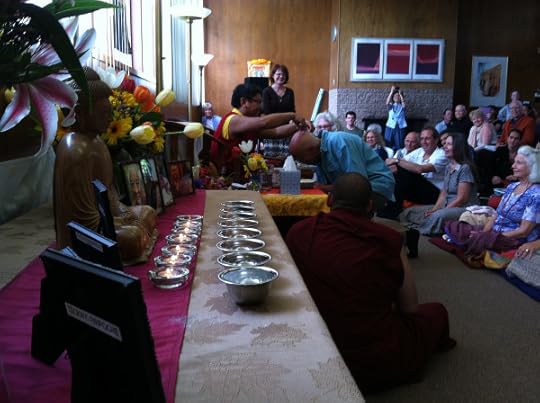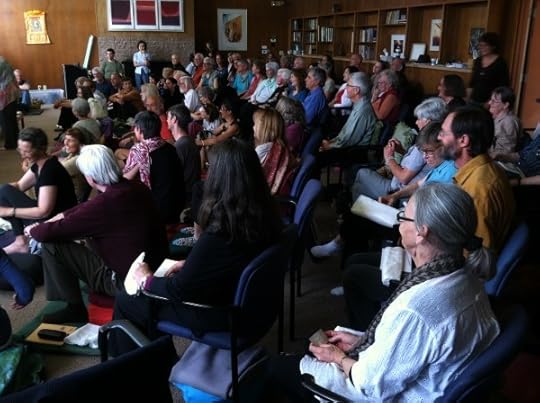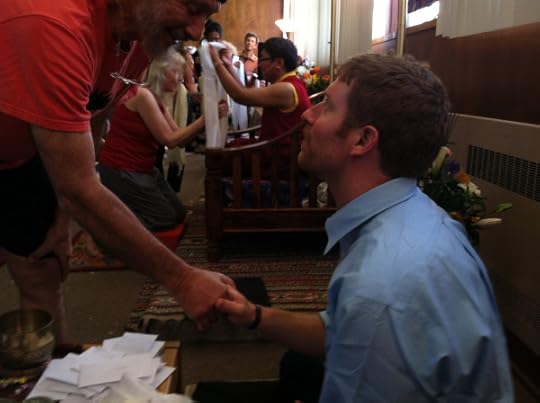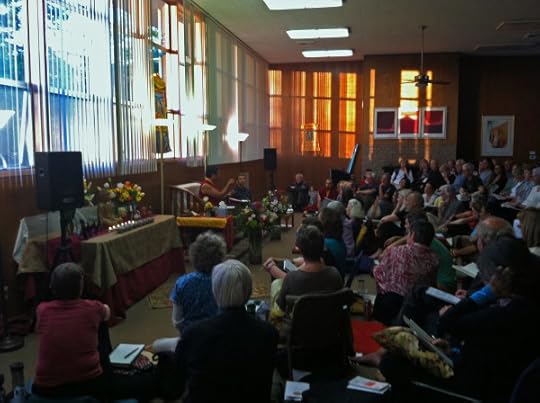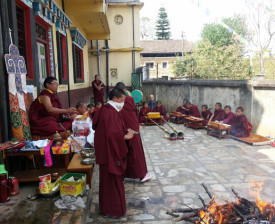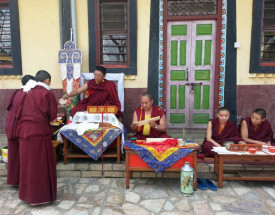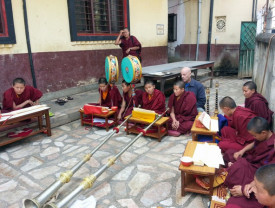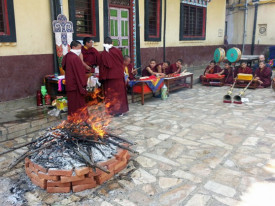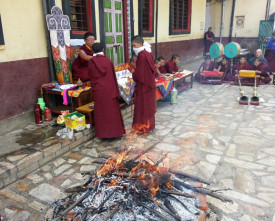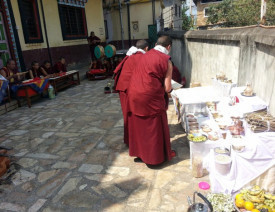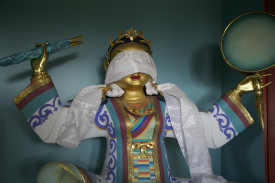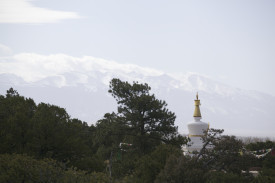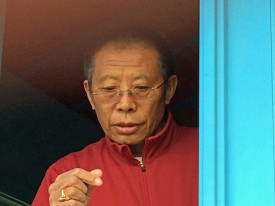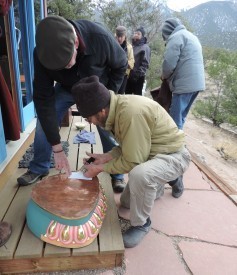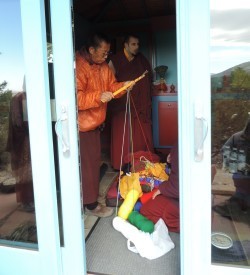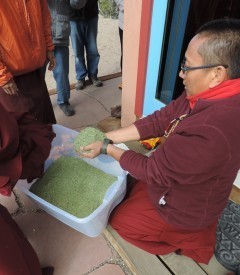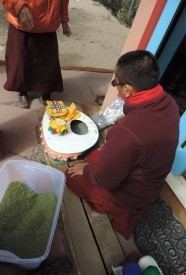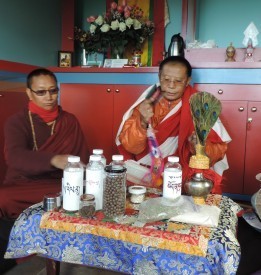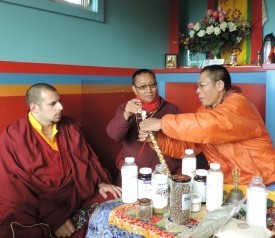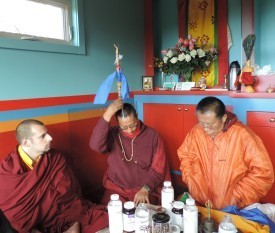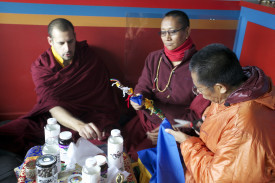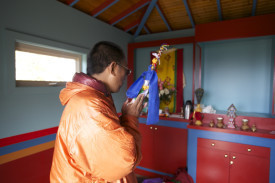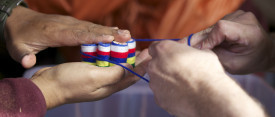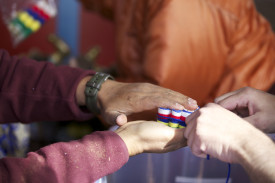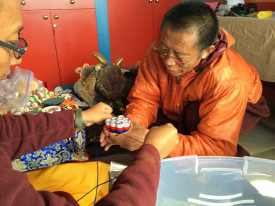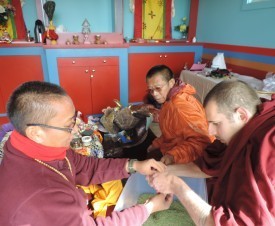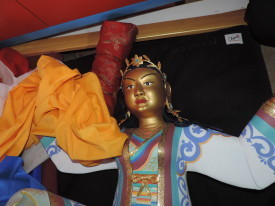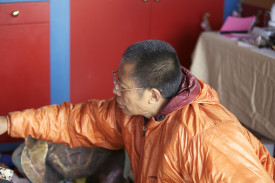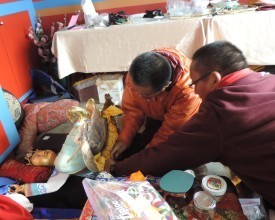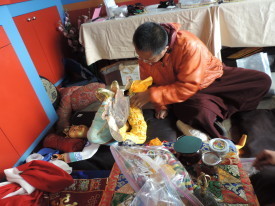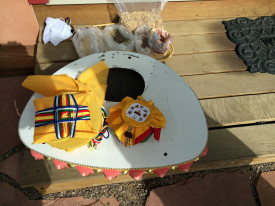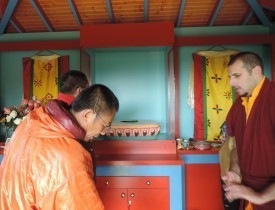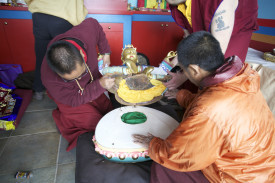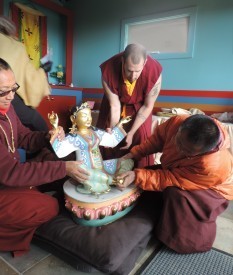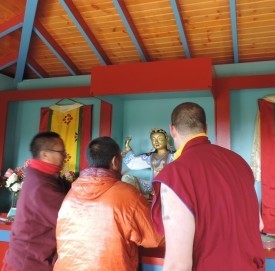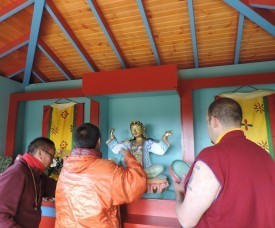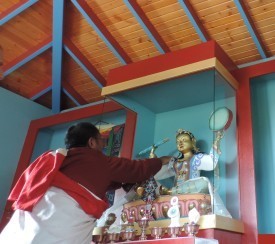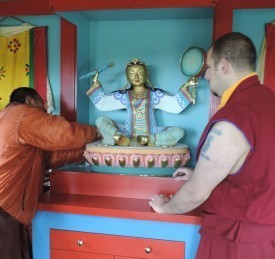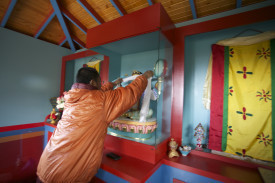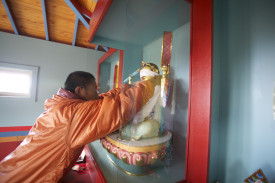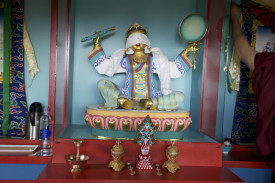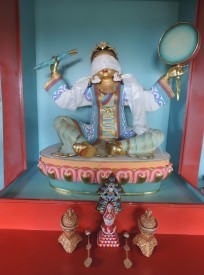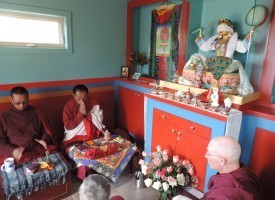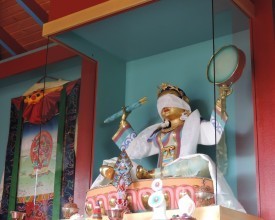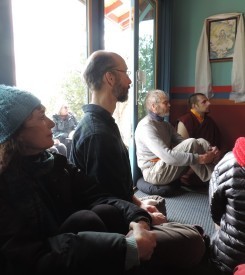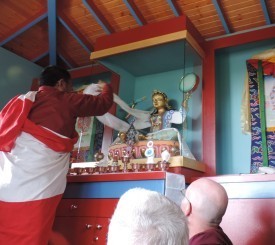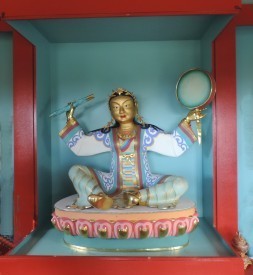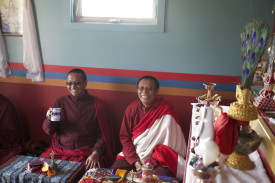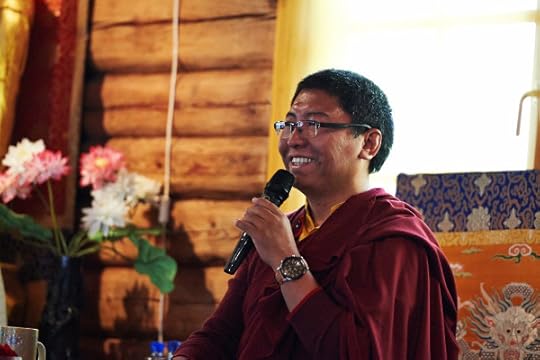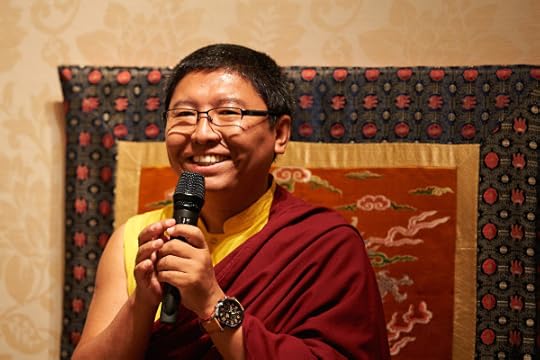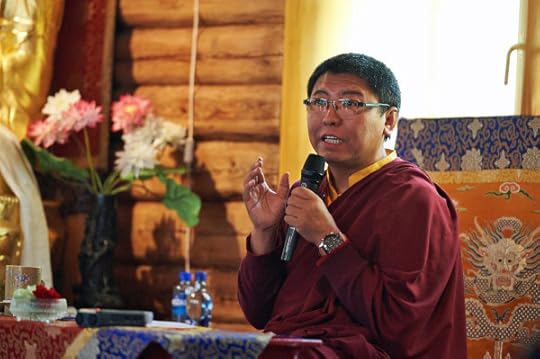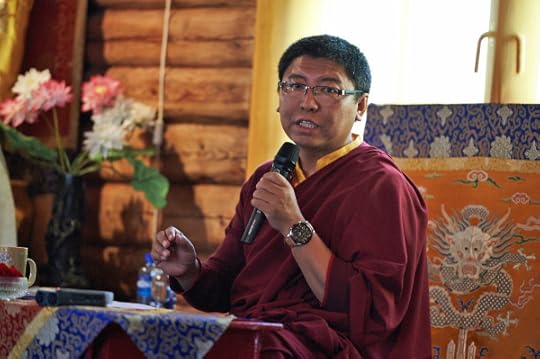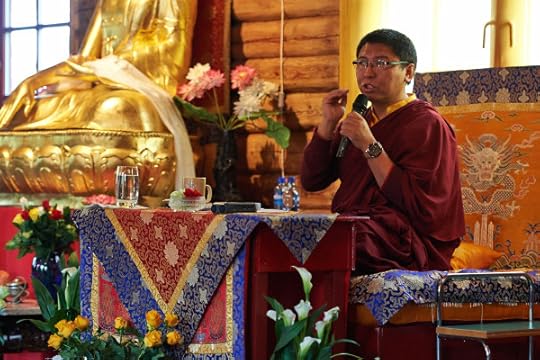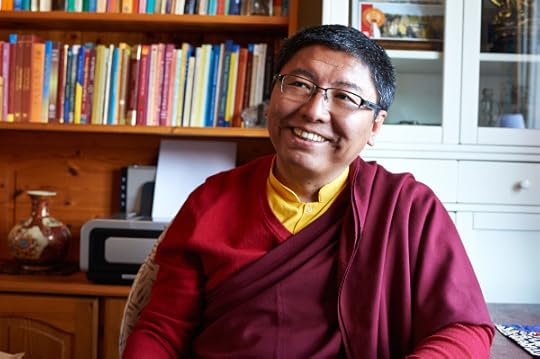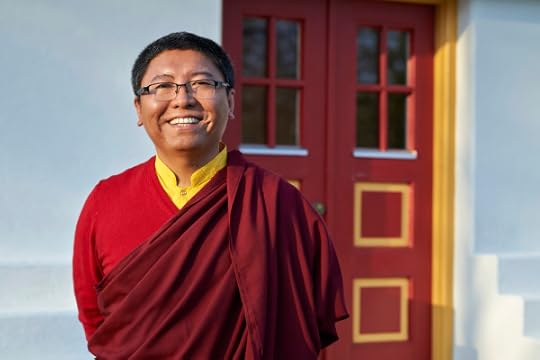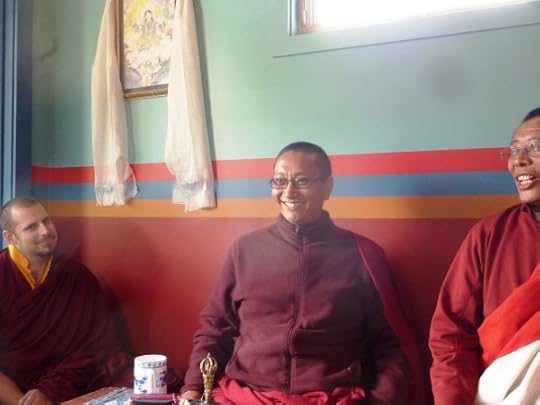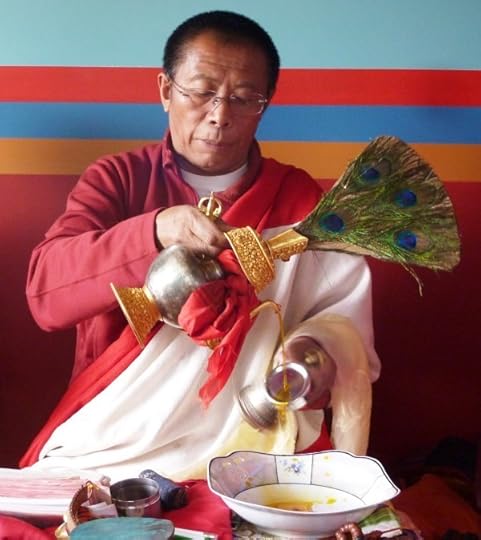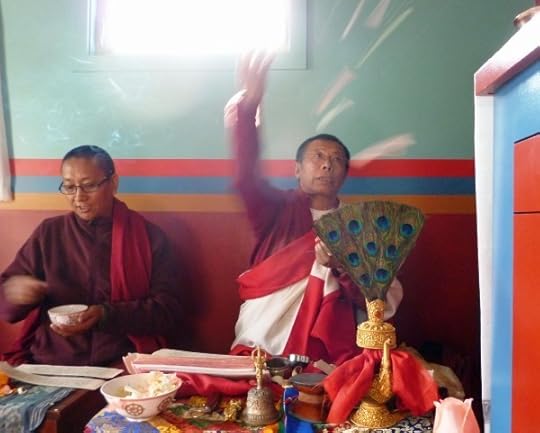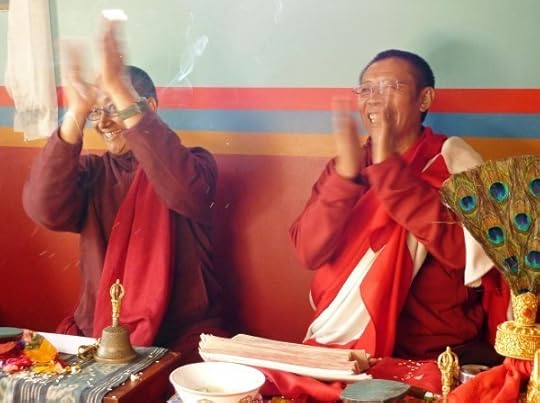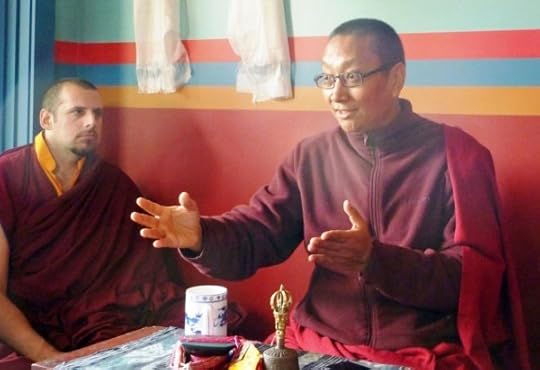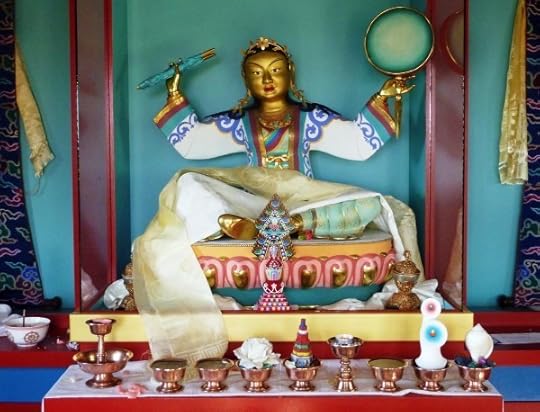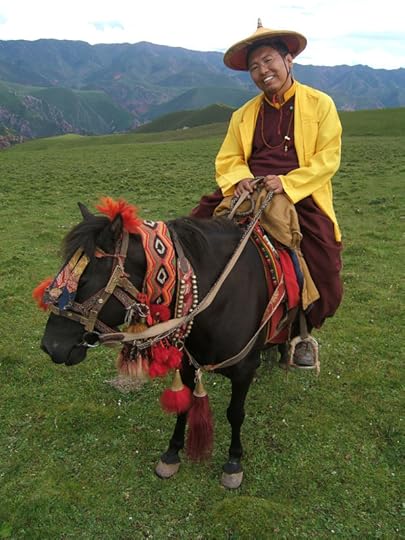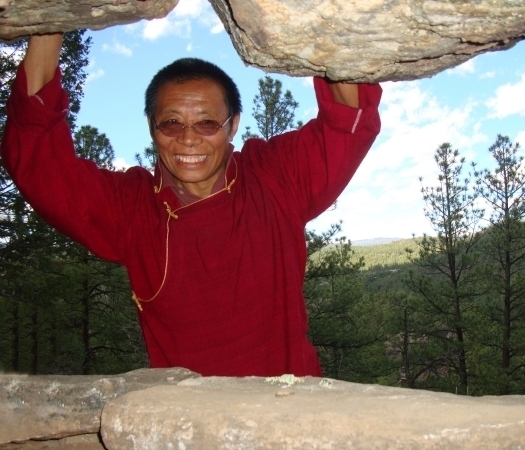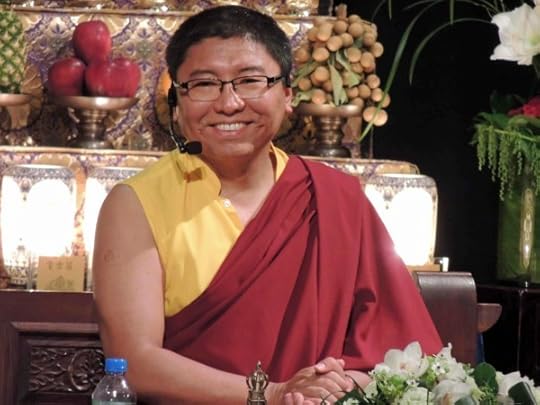Tsoknyi Rinpoche's Blog, page 16
June 15, 2014
On the Passing of Shamar Rinpoche
June 12, 2014
Three Rivers Retreat
The Upaya Zen Center of Santa Fe, NM, hosted “The Great Tributaries Retreat: Exploring Compassion, Wisdom and Emptiness in Three Buddhist Schools” (aka the “Three Rivers Retreat”) May 10 – 12, 2014. Upaya provided a rare opportunity to compare and contrast three schools of Buddhism: Dzogchen, Zen, and Vipassana each represented by Tsoknyi Rinpoche, Roshi Joan Halifax, and Sharon Salzberg respectively. After giving individual talks, these three teachers gathered together and answered questions from retreatants attending from all over the world. As they interacted and shared stories, the obvious affection and respect between the three teachers created a warm container, often filled with laughter. The Upaya setting provided an atmosphere as though you had stepped into a pool of serenity. Thanks to Roshi Joan, her organized, hard working residents and the volunteer staff for an unforgettable experience.
May 23, 2014
Liberating the Heart and Fearless Love at Angela Center, CA
These images mirror the sudden beauty and shifting moods of the retreat mind at the recent program taught by Tsoknyi Rinpoche—Liberating the Heart: Fearless Love, May 2–8, 2014, at Angela Center in Santa Rosa, CA. Moments in the shrine room in the late afternoon light and the Virgin, very much a part of the Angela Center atmosphere, radiate a lovely sense of awareness and care-giving mixed with rigpa resting while illuminating the earth and sky.
Thank you, Nathaniel Dorsky, for these magical impressions. (For more information on the background and experience of Mr. Dorsky, please visit http://en.wikipedia.org/wiki/Nathaniel_Dorsky ).
April 25, 2014
Nepal Nuns Complete Tara Drupchen
The Tsoknyi Nepal Nuns of Gechak Ling, Nepal, held a Green Tara Drupchen that was recently completed on March 23, 2014. Here are a few photographs of the event for your enjoyment!
April 18, 2014
Dorje Yudronma Consecration: Photo Album
Dorje Yudronma is a wisdom deity that manifests out of her compassion in the form of a protectress. Tsoknyi Rinpoche has a special connection with her and asked her to reside on the Yeshe Rangsal retreat land in Crestone, Colorado, in order to help his students clear obstacles to practice and to progress on the path, as well as bless the environment in which she dwells. Dorje Yudronma was formally consecrated on March 22, 2014, by Tulku Sangnag Rinpoche who was requested to do this by Tsoknyi Rinpoche at the Kalachakra Initiation in Washington, D.C. in 2012. Tulku Sangnag was assisted by Khenpo Lobsang from Vajra Vidya Retreat Center in Crestone, as well as monastic Tenzin Namsel.
Tulku Sangnag Rinpoche described in some detail the importance of sacred statues, stupas and other holy sites and objects emphasizing specifically the history of Dorje Yudronma in Tibetan Buddhism and especially in the Mahamudra and Dzogchen traditions. We hope to have this teaching translated and posted on our web site in the future, as well as film clips and additional photos.
View from the Dorje Yudronma shrine looking south at Jangchub Chorten stupa, and Tulku Sangnag Rinpoche overseeing the consecration preparation. Below are a series of photographs showing the preparation of Dorje Yudronma’s rupa and the completion of ‘opening her eyes.’
(Thank you photographers Esteban Hollander, Michael Volchok and Deborah Easley for documenting this portion of the event!)
April 14, 2014
Rinpoche in Oslo: Liberating the Heart
Rinpoche began his 2014 teaching tour at Karma Shedrup Ling Retreat Center near Oslo, Norway (March 30 – April 4, 2014). Below are heart-felt impressions of “Liberating the Heart, Fearless Love: A Dzogchen Approach” by retreatant Heidi Koch and exquisite portraits by Olivier Adam (www.olivieradam.fr)
“Six days of silent retreat in the Norwegian woods—what could sound like a romantic, cosy, maybe even self-indulging and in the worst case spaced-out piece of pleasant spirituality actually turned out to be tough work on the self-to-be-overcome—from the basic tasks of observance and mindfulness, healing and arriving in clarity up to the even harder part of letting go and non-doing and seeing the essence. Each of Rinpoche’s seminars is a new, fresh, and most inspiring experience on its own.
“What a perfect place for such a retreat to unfold its beneficial effects, Karma Shedrup Ling! This area is in the forest, quite remote from Oslo, so quiet and adorned by beautiful landscape, breathing the blessings of great masters who have come to visit, teach and guide the Sangha over the years. A group of dedicated practitioners built this centre out of love and are running it with great care and responsibility, including Lama Changchup and Ani Könchog Lhamo, who was happy and grateful for Rinpoche to return to Oslo for the third time after seven years.
“Sixty-five people participated in the retreat, mostly from Norway but also coming from Sweden, Scotland, Germany and the Netherlands. Norwegians, not being very talkative anyway, are good at keeping silence, which seems to match their temperament. Using his own well-known scale of meditation style, Rinpoche ranked the locals close to the Germans, meaning discipline was present, as well as intelligence, much to his satisfaction: ‘I think it was a very good retreat, from my view! You kept silence very well!’
“Rinpoche balanced the teachings impressively so that they suited the variety of his students: from very young and new in the Dharma—yet enthusiastic and highly motivated, to the older and sometimes very experienced Sangha members, including some Western Dharma pioneers. Gerardo Abboud’s translations and dialogues with Rinpoche served as interpretations, teachings and entertainment equally.
“There was nowhere to hide. Rinpoche would point out to us our subtle misconceptions with utmost clarity, only to uproot and dissolve them in heart-warming humour and radiant compassion one after the other. He invoked the great realized masters and his own teachers in order to bestow pointing out instructions, but by this time most everyone had already generated such devotion to Rinpoche, representing himself what he was calling upon, that the blessing and inspiration were abundant. ‘You cannot teach devotion—it needs to happen!’ and, ‘It will change your relationship with sentient beings.’ Tears of gratitude and genuine appreciation were all around.
“Rinpoche hopes to return to Norway in the not too distant future: ‘I was very tired in Nepal, came here, rested, nobody came here to disturb!’ Thank you Rinpoche!”
March 24, 2014
Dorje Yudronma Consecration Preview
Here is a preview of Tulku Sangnag Rinpoche consecrating Dorje Yudronma this past Saturday (3/22/14). We will be posting many more photos and a commentary on the events of this milestone day at Yeshe Rangsal in the near future.
Tulku Sangnag beaming inside the shrine.
Namsel, Khenpo Lobsang and Tulku Sangnag smiling.
Pouring on mirror during ceremony.
Celebrating with incense in the air and offering rice.
Joyful celebration and applause at the completion of the consecration.
Namsel looks on as Khenpo Lobsang enthusiastically translates Tulku Sangnag’s teachings on holy sites, sacred objects, as well as Dorje Yudronma.
Dorje Yudronma at the end of the consecration ceremony!
(Thank you, Konchog Norbu for these lovely photographs.)
March 1, 2014
Losar Tashi Delek! Year of the Wooden Horse
Dear Friends and Students,
I’m now in a very sacred place, the center of all the Buddhas. Buddhism came out of Bodhgaya; many past Buddhas became enlightened here, and many future Buddhas will become enlightened here. Right now, I am receiving teachings from Khenchen Namdrol Rinpoche on the Guhyagarbha tantra, one of the highest tantras. So within this ground of a special place and a special time of receiving teachings, I would like to give my Losar (New Years) greeting to all my students and friends.
During this auspicious time of the Tibetan New Year, I will remember all of you and keep you in my prayers, here at the spot of Buddha’s enlightenment. I will pray for all of you to purify all obstacles and obscurations on your spiritual path, and to accomplish the level of Buddhahood.
I hope all of you will use your time wisely and meaningfully, because time is very precious and time is passing. Please remember impermanence, in a positive way. We are still alive; we can celebrate this New Year. We have a fortunate life, and in this life we have to aim for positive thinking and action. We can discover the real meaning of life—to find our innate nature of mind, which is the mind of all the Buddhas and bodhisattvas. Our innate mind is not different from the Buddhas and bodhisattvas, but we are covered by obscurations. These obscurations, however, are temporary. We are deluded within them, but this delusion is not our ultimate reality. We can become awakened. The Buddhas and bodhisattvas are awakened from this temporary, seeming obscuration. So please focus on that. I will pray for that. May this coming year be a meaningful year for you.
I’m ready to start this year’s travel to different places around the world, so we will soon meet each other in person. Also, the nuns at Tsoknyi Gechak and Tsoknyi Gargon nunneries will remember all of you. Right after New Year’s, we will have a drupchen—nine days of prayers and chanting. During this time we will make prayers for all of you.
Losar Tashi Delek! (Happy New Year!)
With love,
Tsoknyi Rinpoche
February 28, 2014
Dorje Yudronma Consecration
On behalf of Tsoknyi Rinpoche and the Pundarika Foundation, we are happy to announce that Saturday, March 22nd and Sunday, the 23rd, will be dedicated to the filling and consecration of Dorje Yudronma on the Yeshe Rangsal land in Crestone, Colorado.
Tulku Sangnag has kindly agreed to travel here from Santa Fe, New Mexico, to do this at Tsoknyi Rinpoche’s request. As we learn more from Tulku Sangnag on how the two days will unfold in terms of time and the sequence of events, we will let you know. We will definitely send out an e-mail on March 21st in the evening concerning the timing of things.
Because the ceremony is in the unheated shrine building, it is important to dress warmly should the weather demand it. Gratitude to everyone who helped gather the filling materials, and we hope as many of Tsoknyi Rinpoche’s students and those who are interested and connected to Dorje Yudronma can participate in the consecration.
The Pundarika Staff
February 25, 2014
Tsoknyi Rinpoche Featured in Hong Kong Newspaper
(Note: This article appeared in Hong Kong’s newspaper, the South China Morning Post on November 25, 2013, after Rinpoche’s historic teachings there.)
“As the practice of meditation gains mainstream acceptance, a visiting Tibetan Buddhist master tells Chan Tse Chueen (tsechueen.chan@scmp.com) how it has helped him.
“For someone regarded by the Tibetan Buddhist faithful as a reincarnated master teacher of the dharma, Tsoknyi Rinpoche is remarkably frank about his own human frailties. It took him seven years to stop drinking a certain popular brand of soda, which he knew was bad for his health.
“This story, which he shared last month with a Hong Kong audience at a series of talks on death and meditation, is typical of his teaching style–honest, amusing and direct. It makes accessible the lofty topics of his concerns: the limitless potential of our mind, the nature of reality, and happiness.
“His soda anecdote speaks to those of us who find it difficult to bridge the gap between knowledge and action, which happens, he explains, when the head fails to communicate with the heart. This disconnect, and how meditation can help us to bridge that gap, is a message Tsoknyi Rinpoche carries with him to lectures and retreats in Europe, America and Asia.
“We don’t have to live our life bound by the habits of feelings and behaviour which we have developed over the years; we can choose otherwise, he says, by re-educating ourselves through the practice of meditation.
“In the crowded market today for self-help programmes designed to improve health and well-being, meditation is gaining mainstream credibility. Mindfulness training is now an acceptable tool in psychotherapy, and its ability to “rewire” our brain has become more fact than fiction, thanks to advances in neuroscience research that demonstrate it. Benefits of meditation found through various studies include reduced stress; better concentration; a more resilient mental outlook; lower risk of death, heart attack and stroke in mental patients; reduced loneliness in older adults; and relief from chronic inflammation.
“More research is being conducted. In one study that investigates meditation’s effect on stress, announced a fortnight ago, the Scripps Translational Science Institute in San Diego teamed up with the Chopra Foundation and the Chopra Centre for Wellbeing to collect physiological data from 40 meditators aged 20 to 72, including blood pressure, heart rate, brain activity and other vital signs.
“The study might, for the first time, demonstrate the immediate influence of meditation on blood pressure and markers of stress, and eventually guide better and more individualised treatments of high blood pressure, chronic pain or other health conditions, said the Scripps institute’s director, Dr Eric Topol.
“It’s no wonder stressed-out urbanites are turning to meditation courses for relief. It’s unknown how many practise meditation in Hong Kong, but talks and courses featuring well-known visiting teachers, such as Zen monk and author Thich Nhat Hanh, attract full-house crowds. A search online also shows a wide range of courses available here, from the traditional to New Age. Some methods recommend visualisation or chanting, while others teach a varying combination of paying attention to our breath and sensory perceptions. The techniques differ, but the purpose of meditation remains the same: to be aware of our experience as it is, without judgment.
“We live in a society of speed, and have become accustomed to performing the cognitive process of perception-judgment-visceral reaction in a sort of mental shorthand. Before our head can say “wait a minute”, we are already at the mercy of our feelings. With meditation, Tsoknyi Rinpoche says, we slow down the leap from perception to judgment, giving us a chance to change our reaction through experience. We learn to “be” before we “run”, so we can be steady on our feet even when we live life at full speed.
“In Tibetan Buddhist tradition, reincarnation is accepted as part of reality. The first Tsoknyi Rinpoche, a teacher of the Drukpa Kagyu tradition (“drukpa” being the Tibetan word for “dragon”), was born in the mid-19th century. His third incarnation was found in Nepal–an eight-year-old boy born in 1966 into a family of respected meditators.
“The transition from boy to monk was not at first easy. As Tsoknyi Rinpoche put it in his 2012 book, Open Heart, Open Mind, “One day you’re a boy playing games with local children; the next day you’re a dragon”.
“At the monastery in India where he was sent for training after he turned 12, he grew to enjoy the rigours of study, but could not reconcile his free-spirited nature with the boundaries set by monastic life. So, at 22, he asked to be released from his vows.
“Tibetan Buddhism has a tradition of lay teachers, so his decision was perhaps not as dramatic as it sounds. His father Urgyen Rinpoche, after all, was a renowned meditator who taught and raised a family at the same time. So Tsoknyi Rinpoche left the monkhood, got married and continued to teach. “I had the teaching, which I really believe in. It doesn’t matter whether you’re a monk or a householder, the mind is important, the way we think is important,’ he says. ‘I carry my meditation training into my life, including my marriage.’
“The father of two daughters learns by practice, as lay people do. This means trying to balance his family life with his duties as a teacher, which includes overseeing two nunneries in Nepal and the Pundarika Foundation he founded, and being on the road four to five months a year.
“It means figuring out how to keep his marriage healthy and fulfilling. In the end, it comes down to our ability to connect with ourselves. ‘There are three kinds of love: basic love; normal love, which involves giving and taking; and boundless love, which is love with compassion, a spiritual kind of love. In any relationship, we must first have within ourselves what I call essence love. It’s not self-love, but a sort of ‘okayness’ within yourself that has nothing to do with your partner, your parents or anybody else. You feel a warmth inside, you feel good but not because of something. If you have that, your relationship with your wife–with anybody– will go well.’
“His teaching is peppered with stories from his life experience and interactions with people. He talks about his parenting experience, for example, in his book and occasional column for The Huffington Post. Tsoknyi Rinpoche is undoubtedly counted among a new breed of meditation teachers who have not only made the 2,500-year-old insight of the Buddha relevant in modern life, but also taken it out of the meditation halls and into the world. He is convinced that the practice of meditation, which helps us to become “fully, healthily human”, cannot be separated from our daily conduct. The meditation techniques he teaches therefore fit easily into the rhythm of city life. ‘Or do you like to meditate only on a cushion in your room? No point, no? You can’t stay in the room forever,’ he told his Hong Kong audience at his talk. ‘I hope you have a life–a life besides sitting on a cushion.’
“But given the many methods available here and online, how do we choose one that suits us? His advice is to try each and see; if it works, our life will become better. The ultimate purpose of meditation is liberation from samsara, the cycle of death and rebirth. But if enlightenment is a step too far, meditation can at least help us to heal the bridge between our head and heart.
“‘If we are living in a nightmare, at least we try and turn it into a healthy dream,’ he says. ‘We’re still asleep, we’ve not become awakened like Buddha, but at least we’re no longer in a nightmare.’”


